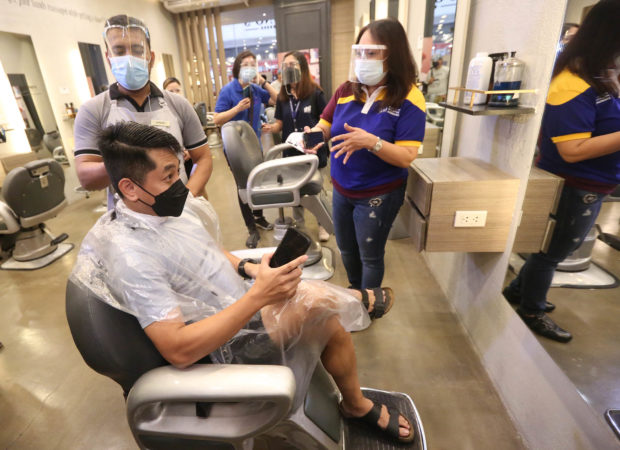Metro ‘winning’ fight vs Delta, says OCTA

HEALTH PROTOCOL CHECK Trade Undersecretary Ruth Castelo inspects a barber shop at a shopping mall in Taguig City on Monday to check if minimum public health protocols are followed as the government studies the easing of COVID-19 restrictions in Metro Manila this month. —MARIANNE BERMUDEZ
MANILA, Philippines — Metro Manila is now at “moderate risk” and “winning” the battle against the more transmissible Delta variant of the novel coronavirus, a fellow of the OCTA Research team said on Monday.
Speaking at the Laging Handa public briefing, Dr. Guido David, OCTA Research fellow, said the National Capital Region (NCR) may already be placed under the less restrictive alert level 3 or even alert level 2, as it has succeeded in reversing the recent surge in coronavirus cases believed to be caused by the Delta variant.
The Department of Health (DOH) determines the COVID-19 situation in a given area, based on five alert levels, the first being the least restrictive.
“The Delta variant cases are not yet wiped out, but they’re becoming fewer. We’re already winning against the Delta variant, that’s what we can say,” David said.
“But efforts to really secure our victory against the Delta variant must continue because our ICU (intensive care unit) utilization rate remains a bit high, admittedly, although all other indicators are going down,” he added.
‘Endgame’
At his press briefing, presidential spokesperson Harry Roque said there was “a high chance” that alert level 4 in Metro Manila would be lowered, as he cited DOH data showing a decline in the reproduction number and in the hospital utilization rate, apart from ICU bed utilization.
If the positivity rate in the capital region, currently at 12 percent, goes down to less than 10 percent, “we can already say that the tests we are doing in Metro Manila are really a bit enough already,” David said.
He noted further that Delta variant-driven cases in the surrounding regions of Calabarzon (Cavite, Laguna, Batangas, Rizal, and Quezon) and Central Luzon are also on the decline.
“This is what we call the endgame of the Delta variant,” he said.
He said authorities should target lowering COVID-19 cases to 5,000 daily by November, and between 2,000 and 3,000 by December for the whole country.
“Of course it remains important that we continue complying with our health protocols [such as] wearing face masks and social distancing. Let us not join large social gatherings just yet; we can go to small gatherings maybe for now, until the number of cases goes down and we’d be at low-risk [classification],” David said.
The DOH appealed to local government units (LGUs) to set priority lanes for the elderly and adults with health risks, even as it said the government would now allow COVID-19 vaccination for the general adult population.
Broader vaccination
“Vaccination will now start in the general adult population. Secretary [Carlito] Galvez [Jr.] said we have enough supply of vaccines,” said Health Undersecretary Maria Rosario Vergeire at her press briefing on Monday, referring to the vaccine czar and chief implementer of the National Task Force (NTF) Against COVID-19.
“It has begun or it can now begin, but we ask our LGUs for special or dedicated lanes for senior citizens and persons with comorbidities,” she said.
On Friday, the government will also pilot the inoculation of 12- to 17-year-old minors with medical conditions in select hospitals in Metro Manila.
Based on the latest data from the National Vaccination Operations Center, more than 7.5 million residents in the capital region have been fully vaccinated. The target is to vaccinate 9.8 million people comprising 70 percent of the 14-million population in the metropolis.
Nationwide, 26,486,522 have been inoculated, according to the NTF. Of that figure, 87.5 percent, or 23,186,969, have been fully vaccinated.
The task force said the country had procured or received 86,494,050 COVID-19 vaccine doses as of Sunday, and a total of 49,673,969 have been administered.
The government started its COVID-19 vaccination drive on March 1, with the initial priority groups being the medical front-liners (A1), seniors (A2), persons with comorbidities (A3), workers in essential sectors (A4) and indigents (A5). Overseas Filipino workers have been included in the A1 priority group.
Case update
The DOH reported 8,292 new infections and 36 more deaths due to COVID-19, bringing the total coronavirus cases to 2,674,814 and total deaths to 39,660.
There are 98,894 active cases, of which the majority, or 74.4 percent, are mild, 15 percent are asymptomatic, 6.14 percent are moderate, 3.2 percent are severe and 1.3 percent are critical.
Monday’s case bulletin showed that 16.5 percent of 52,352 individuals tested on Saturday were positive for the coronavirus.
There are 302 new recoveries, bringing the total to 2,536,260.
Of the hospital beds nationwide, 69 percent of ICU beds, 53 percent of isolation beds and 54 percent of ward beds are currently utilized, along with 50 percent of ventilators.
Two laboratories failed to report their results in time for Monday’s bulletin. INQ
For more news about the novel coronavirus click here.
What you need to know about Coronavirus.
For more information on COVID-19, call the DOH Hotline: (02) 86517800 local 1149/1150.
The Inquirer Foundation supports our healthcare frontliners and is still accepting cash donations to be deposited at Banco de Oro (BDO) current account #007960018860 or donate through PayMaya using this link.